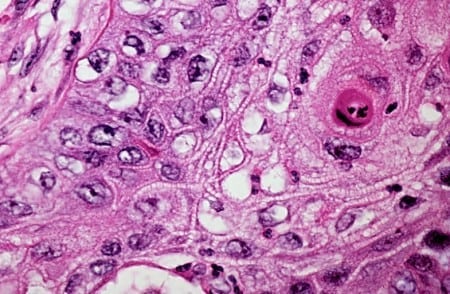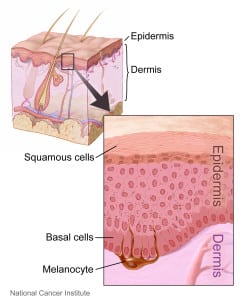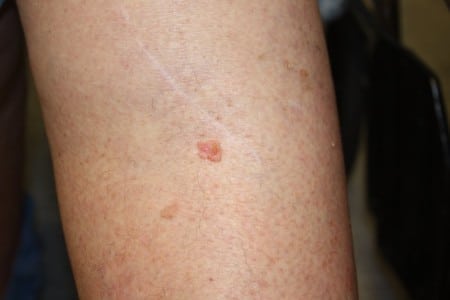What is Squamous Cell Carcinoma?
Posted on August 6, 2015 in Cancer
Skin Cancer 101: What is Squamous Cell Carcinoma?
Written By: SERO Board-Certified Physicians
In the U.S., an estimated 700,000 new cases of squamous cell carcinoma are diagnosed every year.
Squamous cell carcinoma (SCC) is a type of skin cancer characterized by the uncontrolled growth of damaged or mutated squamous cells.
The second most common form of skin cancer, squamous cell carcinoma accounts for 700,000 new cases each year in the US alone. While rarely life-threatening when caught early and treated appropriately, SCC is more dangerous than basal cell carcinoma, a more common form of skin caner—it is estimated that between 4,000 and 8,000 Americans died from squamous cell carcinoma in 2012.
What are squamous cells?
Our skin is made up of several different types of cells, each serving a different role in promoting the healthy functioning of the skin. Skin is composed of two main layers—the epidermis forms the top layer of skin, while the dermis, which contains blood vessels, hair follicles, and the like, form the lower level. Squamous cells make up most of the skin’s top layer.
Accordingly, the word “squamous” comes from the Latin squama meaning “the scale of a fish or serpent.”
Squamous cells are some of the body’s most common. Along with making up the much of the epidermis, they also compose many of passageways of our respiratory and digestive systems. They are often found in the linings of organs.
What is squamous cell carcinoma?
Squamous cell carcinomas are lesions or tumors that form in skin’s squamous cells. SCCs most commonly form on areas of the body that are frequently exposed to the sun over long periods of time, such as the ears, face, scalp, neck, hands, arms and legs, but may also appear anywhere on the body, including mucous membranes, lips, and genitals.
Like all forms of cancer, squamous cell carcinoma is the result of a mutation to the DNA of the cell that cause it reproduce rapidly and uncontrollably. If SCCs are left untreated for too long, they may become highly disfiguring, or even deadly.
What do squamous cell carcinoma look like?
Squamous cell carcinomas may appear on patches of the skin regularly exposed to sunlight. They appear as bumps of growths with some common characteristics:
- Scaly red patches
- Open sores
- Raised growths with a divot, dimple, or depression in the center
- Warts
- Crusty or bleeding bumps
Warning Signs
Squamous cell carcinoma is highly curable when discovered and treated in its early stage. However, SCC can be extremely disfiguring, even deadly, if not treated promptly.
Skin that has been damaged by the sun may often be at risk of developing SCC.
Check regularly for common indicators of sun damage:
- Wrinkles
- Changes in skin tone or pigment color
- New or changing moles
- Freckles
- Age spots
- Skin stiffness
- Broken blood vessels
Causes and Risk Factors
Exposure to UV light, either from the sun or from tanning beds, particularly if is chronic, long-term, and/or result in a blistering sunburn, is believed to be the primary factor in the development of squamous cell carcinoma, although many environmental and genetic factors are likely involved.
Many risks factors are associated with squamous cell carcinoma, ranging from hair color and skin tone to family history. Below are some of the characteristics that result in higher risk of developing the cancer:
- Fair skin
- Blond hair
- Light-colored eyes
- Family history of BCC
- Previously having BCC, specifically on the nose or scalp
Treatment Options
Should one discover that he has SCC, there are many treatment options available, and each option has shown high rates of success. The following treatment options are just a few of the many that exist for SCC:
- Excision:
- An minor, outpatient surgical procedure during which the patient is given general anesthesia and the affected area is cut away.
- Mohs surgery:
- Pronounced “moes,” this specialized surgery is used specifically for skin cancer. A dermatologist will cut affected skin away layer-by-layer, using a microscope to make sure all cancer cells have been removed on the bottom layer.
- Radiaton
- Radiation oncologists, such as those at SERO, utilizing radiation therapy to completely eradicate the tumor over the course of several weeks of radiation treatments.
- Curettage and Electrodessication
- Generally performed on smaller lesions where growth is scraped off with an instrument with a sharp, ring-shaped tip (a curette), and the tumor is burned.








